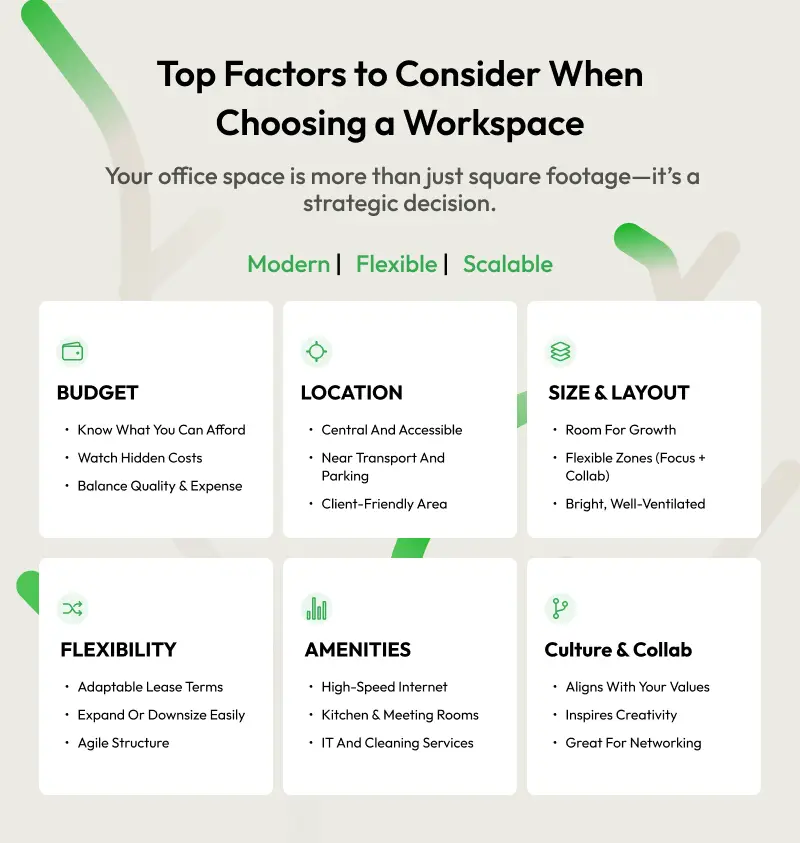Choosing the right office workspace is more than just a logistical decision—it’s a key factor in how well your business performs. The space you and your team work in can directly impact productivity, morale, collaboration, and overall business growth.
A well-matched workspace supports focus, creativity, and connection, while also reflecting your company culture and values. Whether it’s a vibrant coworking space full of networking opportunities, a quiet private office that offers control and professionalism, or a flexible remote or hybrid setup, the right environment sets the tone for success.
In this guide, we’ll explore the different types of workspaces available, the pros and cons of each, the key factors to consider when choosing one, and how to successfully transition into your new space.
Contents
- 1 What are the Different Types of Office Work Spaces?
- 2 What are the Factors to Consider When Choosing a Workspace?
- 3 How to Choose the Right Office Workspace for Different Business Needs?
- 4 How Should You Evaluate A Potential Office Work Space?
- 5 How to Transition to Your New Workspace?
- 6 The Bottom Line
What are the Different Types of Office Work Spaces?
The office environment is a defining factor for many companies’ long-term success. An open, well-organized space can encourage collaboration and creativity and boost productivity and morale.
Investing in the right space is a huge step, especially for start-ups. Before you do, it’s essential to know the different types of workspaces as well as their pros and cons:
-
Coworking Spaces
A coworking space is an office environment where individual workers and team members come to work. They provide an alternative office environment for freelancers, remote workers, and start-ups.
PROS
- Coworking spaces are a great office work space that offers the full benefits at a fraction of the cost.
- These spaces are highly flexible with the added benefit of having an ideal environment for networking.
CONS
- Coworking spaces lack privacy, which may be challenging for teams who need separate spaces for holding meetings.
- Regular foot traffic can also distract those tackling focus-oriented tasks.
-
Private Offices
A private office is the opposite of the more open coworking space. They are lockable rooms in all sizes and configurations and offer a more professional environment.
PROS
- The biggest advantage of a private office is having more control over your work environment.
- Aside from promoting focus, it can also help land a great first impression for clients.
CONS
- A private office work space is more expensive and less flexible than a coworking space.
-
Home Office
The home office is exactly what it says: an office environment in the comfort of your home. More specifically, it’s a section of your home dedicated to official business. Here are its pros and cons:
PROS
- Home offices are a fantastic option for entrepreneurs, freelancers, or start-ups.
- They cost very little while offering the most comfort and flexibility.
CONS
- You are more prone to distractions because you work at home.
- You also experience a lack of separation between your work and home life.
-
Hybrid Workspaces
In a nutshell, the hybrid workspace is a combination of different office layouts in the same workspace. The different types of spaces available means team members choose which type of space they want to work in.
With over half of all workers preferring hybrid work setups, the hybrid workspace is a perfect complement. Here are its pros and cons:
PROS
- The hybrid office work space can accommodate various work styles.
- Individuals can adapt the space to suit their needs as their activity patterns change.
CONS
- Hybrid spaces can be challenging to manage.
- They often depend on tools like desk and room reservation software to ensure seamless collaboration between teams.
-
Virtual Offices
The virtual office is a remote office work space where teams are connected via the internet. It uses online file sharing and messaging tools, such as cloud-based software and voice-over Internet protocol (VoIP) telephony.
PROS
- It empowers businesses to only register a physical address while staying connected with teams worldwide.
- Without expensive real estate costs, they can fully maximize their savings.
CONS
- Because all work is done remotely, there is often no in-person contact.
Find Your Perfect Workspace Today
Browse hundreds of flexible workspaces tailored to your needs—coworking spaces, private offices, meeting rooms, and more.
What are the Factors to Consider When Choosing a Workspace?
A physical office isn’t just a space for daily operations. It can directly affect team member productivity and engagement, your company’s image, and overall client accessibility. Because of these reasons, choosing the correct location can significantly impact your company’s long-term success.
Here are the factors you should consider when choosing your own office work space:

-
-
Budget
Budget is the first and most crucial factor when choosing your office space. You need first to understand your financial capabilities, particularly whether your business can afford an essential investment.
Next is recognizing the hidden costs in different types of workspaces. For example, while a workspace is cheap at first, you may spend more on renovations or furniture.
Finally, you need to understand how to balance a workspace’s cost and quality. You can maximize space with ergonomic furniture, adopt sustainable practices, and promote flexible work setups.
-
Location
Ideally, your office work space should be accessible to clients and team members. It should also make other resources accessible to you and your team.
Many businesses are located in central business districts because of location and accessibility. When public transport is easily available, it can cut down commute times while making your office appealing to clients.
On top of that, you should make sure your office space has enough parking spaces. Limited parking can also be a setback for team members and visitors.
-
Size and Layout
Matching your office space with your team’s current size and capabilities is important while leaving room for future growth. Spaces that are too small can be counterproductive, while large spaces can bring unnecessary costs.
Aside from size, your office work space should have varying layouts for different purposes. For example, private offices for focus-oriented tasks should be provided, while meeting rooms and open offices should be created for more collaborative tasks.
Regarding layout, one with access to natural light, good air quality, and comfortable temperatures. Many studies show that these can decrease absenteeism by four days.
-
Flexibility and Scalability
While team size can be a factor, you should also ensure that your office space can scale with your growing operations. Doing so will let you hire more team members.
You also want your workspace flexible enough to scale up or down as needed. Aside from the workspace, your lease contract should be flexible enough to let you adjust alongside your business.
-
Amenities and Services
Amenities like meeting rooms, kitchen facilities, and high-speed internet can be optional, but can greatly enhance a workspace. However, depending on your needs, these amenities are crucial for your office work space.
Investing in your dedicated office space also means investing in amenities for your team. If you want to opt for a coworking space instead, you should also look for IT support, cleaning, and security.
-
Company Culture and Collaboration Needs
Finally, be sure to account for your company’s culture and values when choosing a workspace. The reason is that different workspaces can encourage different mindsets, which can foster or hinder collaboration and creativity.
Social environments can also influence team engagement, especially if it supports their lifestyle. Many businesses often set up near similar businesses as a result.
-
How to Choose the Right Office Workspace for Different Business Needs?
Not every office work space is made equally. Each one has different benefits and drawbacks that may help or hinder your overall business goals. When choosing your workspace, you should make sure these benefits feed into your needs.

Your business’s size should primarily be considered since it can influence daily operations. Here’s how you can choose the proper workspace accordingly:
-
For Start-ups
If you’re running a start-up company, budget is the main factor for your office space. Dedicated offices require extensive planning and carry a high upfront cost.
That leaves you with coworking spaces as your office work space of choice. Not only are they relatively affordable, but they also offer much-needed flexibility while unlocking opportunities to network and collaborate.
-
For Small to Medium-Sized Businesses
Small- to medium-sized businesses should also consider their budget, but they should have more financial capacity.
If your business belongs in this category, you also want to think about being able to scale up your operations. Hybrid workspaces are the perfect option since they give your business the flexibility it needs.
-
For Large Enterprises
If your business belongs in this category, you have ample budget to consider a dedicated office space. For you, the biggest challenge to choosing your office work space will be space management and utilization.
You should also pay attention to more efficient space management if your business has multiple offices or locations. The right software and digital infrastructure are key to efficient space usage, especially for multiple locations.
The good news is you have more choices in terms of office space. With a robust digital infrastructure, you can adopt a hybrid workspace or have a custom-designed office.
-
For Remote Teams
If you’re managing a remote team, communication and collaboration are crucial to your business’s long-term growth.
A virtual office workspace offers remote work tools and is the best option since it allows teams to connect regardless of distance.
-
For Freelancers and Solopreneurs
Freelancers and solopreneurs should also consider their budget when choosing their workspace. However, if you belong in this category, you also want your environment to be as productive and distraction-free as possible.
Considering these factors, your best options are similar to those of remote teams. However, you can also choose a home office setting to maximize comfort and minimize costs.
Looking for the ideal office space that fits your business needs?
At Othership, we make it easy to discover and book flexible workspaces—whether you’re a startup, freelancer, or growing enterprise. Explore coworking spaces, private offices, or hybrid setups across top locations, all in one place.
How Should You Evaluate A Potential Office Work Space?
The first step in finding the best workspace is to list available office spaces near you. Once you’ve found a shortlist of potential workspaces for your business, you can proceed to the next step.
Because not all spaces are made equally, it’s essential to filter out which suits your business the best. Here’s how you can find the right one:
-
Workspace Tour
Many studies show that an office space’s physical location significantly affects its image. The best way to evaluate it is to make an in-person visit and see it for yourself.
Before signing a lease for your new office work space, be sure to ask the following:
- Lease Terms – With so many office setups available, each facility’s lease terms will include many services at different price points. Ask if the lease covers utilities, equipment access, and more.
- Maintenance and Repairs – If you’re responsible for maintenance and repairs, ask if you can negotiate the percentage you’re responsible for.
- Rent – Certain leases include built-in annual increases. Some increases are set for specific amounts, while others may not include the percentage increase.
- Early Termination Penalties – If you cannot afford the rent, you may need to terminate the lease early. Always ask about early termination policies before signing.
-
Online Reviews and Ratings
If you’re not sure about a prospective office work space, the next step is to do your own research.
More specifically, you want to find online reviews and ratings. Knowing workers’ feedback about a coworking space or a commercial office space can help set proper expectations.
-
Trial Periods
After researching and making the initial visit, you should set a trial period for working in a specific space. This step benefits remote workers, freelancers, and startups when choosing a coworking space.
Trial periods are crucial for evaluating prospective workspaces for a few reasons:
- Atmosphere – The overall work atmosphere and environment can help or hinder productivity depending on your tasks. Workers can expect plenty of noise and distractions if the workspace has plenty of regular foot traffic.
- Information – Businesses are especially price-sensitive. You want to ensure the space will give you the best work experience possible before committing to a membership or signing a lease.
-
Technology and Infrastructure
Technology and infrastructure are the backbone of every modern office work space. High-speed internet, AV equipment, and backup generators can make or break an office space.
How to Transition to Your New Workspace?
Relocating can be an exciting opportunity that opens up other business opportunities, especially when relocating to downtown areas. However, moving to your new office work space can pose certain challenges.

Here’s how you can make your transition as seamless as possible:
-
Planning the Move
The first step is not to pack boxes and haphazardly bring everything to your new location. When moving to your new office work space, many of your daily business processes can be affected.
Start planning early to avoid interrupting your daily operations as much as possible. A checklist of important dates and tasks is crucial to ensure everything is ready when the movers arrive.
On top of that, you should also communicate with your team about any changes and developments. Your IT team in particular should be informed so they can prepare for any changes beforehand.
-
Setting Up the Space
Setting up your new office work space involves plenty of manual labour. Depending on the scope and scale of your business, you may need to hire movers or professional designers beforehand.
Movers help you handle the manual labour of moving equipment and furniture. Meanwhile, professional designers ensure your space is optimized for productivity and collaboration.
-
Managing the Transition
Finally, be sure to have a plan to keep your business running as smoothly as possible while making the move. Here’s how you can minimize downtime while transitioning:
- Assign a Coordinator – Delegating the task helps you organize your transition. A well-organized coordinator can prevent problems by overseeing every detail and working closely with movers.
- Train Your Employees – It’s important to bring your team up to speed on navigating your new office work space. Your moving coordinator can also help streamline this process.
- Declutter and Organize – Moving is the perfect chance to declutter and reorganize. Take this time to review office equipment and supplies and decide what to keep.
The Bottom Line
Businesses’ and workers’ needs and attitudes towards work have changed drastically in recent years. Flexibility is more important than ever in a post-pandemic environment to ensure long-term growth.
That flexibility should also reflect in your office work space. Whether starting out or already successful, you must consider various factors to pick the right office space.
More importantly, assess your current and future needs before choosing a new office space. You can start by exploring more resources and contacting an expert to find out what suits your needs best.




You must be logged in to post a comment.